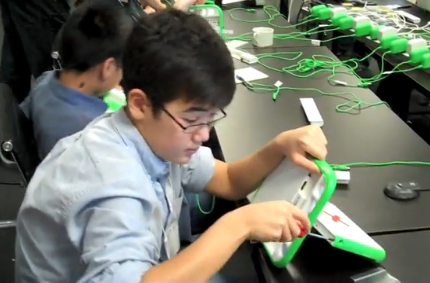Saturday’s OLPC Repair Fest clinic and training was a HUGE Success! Thanks to all those from around town who attended. Check out several videos & photos of the event care of Azamat Abdymomunov.

Yearly Archives: 2010
Repair workshop this Saturday at OLPC HQ
This Saturday we’re holding a repair workshop and presentation — if you haven’t torn down your XO and rebuilt it from the motherboard up, now’s your chance to try on someone else’s machine — and to learn how to break down and rebuild one in under half an hour, with nothing but a Phillips screwdriver!
We’re holding a workshop Saturday through the early afternoon. RSVP if you’re planning to come. The machines worked on will primarily be XO-1’s, since those are still the machines most likely encountered in the field. The major differences on the 1.5 make these sorts of repair much easier, not more complex — there’s little reason to take apart the bottom on a 1.5, for instance, since the keyboards just pop out.
OLPC comes to Doomadgee in rural Queensland
OLPC Australia is in the middle of providing 300 children and teachers with XOs in Doomadgee, Queensland. This continues their work in Aboriginal regions across the continent (see their amazing school-by-school map). I always look forward to the updates of that particular map – which colors every school deployment by whether it is completed or not.
Health Mapping & Education in Emergencies: Exploring New Opportunities for Child Learning and Well-being
At OLPC this morning Rumi Chunara, PhD, a Research Fellow at HealthMap and Harvard Medical School gave an inspiring introduction to her work - http://healthmap.org/en/. It’s a live site that tracks global health issues through local submissions — tracking needs that are pressing a community most direly.
OLPC has been conducting research and fieldwork that focuses on education for children in crises, cutting across areas of crucial needs such as health and shelter. The effects of tools like Health Map and Ushahidi linked to an XO for family and kid support can have untold benefits for providing life saving information to a community. Health Maps can be localized for region and epidemic and we hope to collaborate further on what information can be provided through the forum for XO users in environments at risk across the world.
Informal learning for children is at the core of One Laptop per Child. Recently, Health Maps used their tools to track school closures in the United States as a result of the H1N1 epidemic – by linking school closures with the informal learning opportunities facilitated by the XO we aspire to facilitate uninterrupted access to education for all of the world’s children!
New Assessment Report on M&E Literature
OLPC learns and grows from every distribution, small or large, and actively seeks out feedback, documentation and analysis. OLPC partners and communities are critical contributors in this feedback loop and likewise are usually interested in how monitoring and evaluation studies from different countries can offer insight into successes and challenges of one laptop per child programs. The learning team decided to compile an assessment report of the existing m&e literature to compare different projects, generate discussion, and gain inspiration. Check it out!
If you have your own overview of an OLPC project not featured please consider sharing for future updates to our assessment report!
Building Technical Support in Afghanistan
With roughly 4,000 laptops deployed, we’re still in the beginning stages of the initiative. It’s a good stage to be in, especially for building our technical support in advance. So what’s the best way of doing that?
One idea that has been proposed: setting up partnerships with students at Afghan universities. We’d recruit teams of student volunteers to provide ongoing support to teachers and pilot projects. Throughout the whole process, OLPC would provide ongoing support, feedback, access to spare parts and technical advice. Of course there are still a lot of details to iron out. Right now we’re planning to call it the Afghanistan Children’s Connectivity Project, involving individual Connectivity Centers in community hubs in each region.
This year, the United States Government requested $105.9 billion for military operations in Afghanistan. The numbers break down into $68.1 billion requested by the Department of Defense for 2010 and a $33 billion supplement requested by the Administration to support the 30,000 person troop surge in the area. It’s funny to think that providing every child in the country with an XO would cost about $800 million — or 3 days of that military spending.

